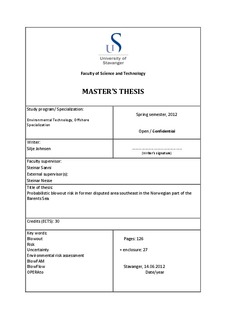| dc.description.abstract | The maritime delimitation in the former disputed area between Norway and Russia was agreed upon in 2011. It is therefore probable that the area will be opened for petroleum exploration in the near future. A blowout represents one of the most severe threats associated with petroleum exploration. This thesis has investigated the risk involved with such an activity through a case study, by considering geology and well specific conditions for this area. Currently, no wells have been drilled in the nearby area. Therefore, there is a lot of uncertainty related to reservoir and well conditions.
The blowout risk was determined in a well specific manner by employing several computer modeling tools. Determination of blowout probability, flow rate and duration was emphasized. This thesis also assessed the associated environmental risk through a methodological study. The main objective of this thesis was to investigate how available computer modeling tools allowed the uncertainty to propagate throughout an environmental risk assessment. This is done by observing how the applied tools could communicate probabilistic elements.
The blowout probability was determined through two different approaches. Both methods applied statistics as basis. A pure statistical approach attempted to reduce the historical blowout probability by considering recent trends in kick statistics. The computer modeling tool BlowFAM adjusted the historical probability by considering reservoir and well characteristics, and through an evaluation of a wide range of risk elements. The latter was also used to identify certain risk reducing measures. BlowFAM was considered to yield the most well specific result of the two approaches, and was therefore chosen as the most appropriate model for this case study. BlowFAM has yielded a blowout probability of 7.58 × 10-5.
BlowFlow is a computer modeling tool used to determine flow rate and duration of a potential blowout in a probabilistic manner. This tool determines flow rate based on a consideration of reservoir and well conditions. The duration is a function of different types of blowout killing mechanisms. BlowFlow considers the uncertainty in input parameters, and reflect these uncertainties in the final results. The results are presented by means of probability distributions for several different scenarios. BlowFlow has yielded a mean flow rate of 1 200 m3/d, and a mean duration of 10 days. The implications of several risk reducing measures was also investigated.
OPERAto is a computer based tool used to determine the environmental risk related to a possible blowout. The risk is determined based on the area of influence, and presence of specific valued ecosystem components (VECs). The model does currently not include data collected from the former disputed area of the Barents Sea. Oil drift simulations and environmental data have been collected from Norne; an oil field in the northern part of the Norwegian Sea. Consequently, the environmental risk presented will not be correct for this case study. OPERAto was applied as a methodological study to determine the compatibility between the different modeling tools, and their ability to reflect uncertainty in input parameters. Also, the effect of implementing risk reducing measures was observed.
Through the methods applied it was possible to determine blowout probability, flow rate and duration in a well specific manner. However, it was not possible to determine the environmental risk in a relevant manner, within the frames of this thesis. Still it was possible to study how these tools communicated, and how the uncertainty was allowed to propagate through the environmental risk assessment. It was concluded that the tools were able to communicate some probabilistic elements, but that there is still a lot of work to be done before a unified probabilistic methodology exists. | no_NO |
